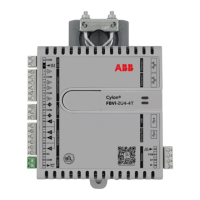BACNET MS/TP
Note: FBVi is IP only, this section is provided for general information.
BACnet MS/TP (Master-Slave Token Passing) is an EIA-485 network layer intended for use with lower-level
devices such as Unitary Controllers. In comparison to BACnet/IP and BACnet/Ethernet, MS/TP is more
cost-effective to implement due to the lower cost of wiring. Given the MS/TP network is a serial-based
network, devices may be configured to communicate at different baud rates specified by BACnet.
Therefore, it is essential to know information regarding the BACnet network you are connecting to
before installing.
TOKEN PASSING
BACnet MS/TP uses token passing to allow devices to communicate on the network. Token passing is
controlled by each device, which contains an internal memory list of other MS/TP peers connected to the
network. The token is passed in order of the MAC Address (Unit ID) from lowest to highest. In most
MS/TP networks, each device is configured to be a master. Given all devices may be a master, MS/TP may
appear and react slower than traditional building automation protocols. However, configuring your
network for faster baud rates will help provide better bandwidth and transport speed of network
messaging.
Token passing is a communications scheme that allows connected devices connected to
intercommunicate with one another. A network “token” is passed from unit to unit on the network in a
round-robin fashion by order of the MAC Address (lowest to highest) to provide a transport to access the
network. When a unit possesses the token, it may perform any network activity for which it is
responsible. When finished, the token is then passed onto the next device. At any time, the unit that
possesses the token is the only device permitted to initiate communications with another device on the
network or to request information from it. A device that receives the token may or may not need to
perform network functions (e.g. read values from a remote device, broadcast information, etc.). If not, it
will simply pass the token along the network.
If you are connecting devices to an existing MS/TP network consisting of third-party devices, consult
third-party vendor documentation regarding MS/TP network considerations.
ADDRESSING
BACnet MS/TP devices contain two device addresses. One device address is known as a Device Instance,
and the other is a MAC Address. The Device Instance is an address assignment that is used to identify the
BACnet device on a global BACnet network. When a device is connected to a global BACnet network
consisting of multiple data layers joined together using routers, the Device Instance is used to uniquely
identify the device on a global basis. The valid range for the device instance in a BACnet device is 0 to
4,194,302. Devices must be configured for a unique, non-conflicting Device Instance. In the event that
multiple devices are assigned the same Device Instance, both devices will simply not communicate on the
BACnet network or could be subject to misdirected messaging (a message intended for Device-A may be
routed to Device-B)
The MAC Address is an address assignment used within the BACnet MS/TP segment to permit a device
to actively communicate on the BACnet MS/TP network. Valid MAC Address assignments range from 0 to
127 and are typically assigned in a logical and incremental order to permit faster token passing between
devices. The MAC Address of a BACnet MS/TP device must be a unique, non-conflicting value that exists
on the local MS/TP network. In the event that multiple devices are assigned with the same MAC Address,
the effects can be far detrimental than that of a conflicting Device Instance; potentially resulting in a
failure of the entire local MS/TP network. In the event that the unitary controller encounters a duplicate
of its MAC Address, devices will inform the user that a duplicate MAC Address has been detected and will
not perform client communications until resolved.

